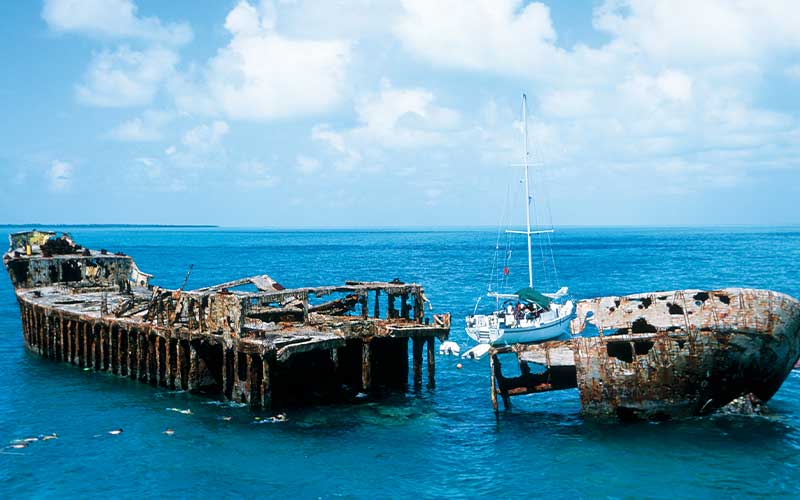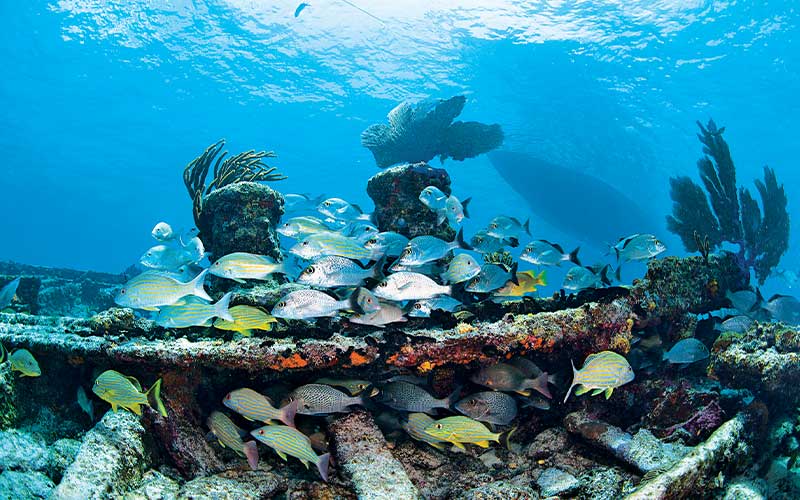I was recently invited to a dive convention in Singapore to present a slide show documenting my three decades as a scuba photojournalist. As I prepared the show, the images seemed to organize logically into several of my favorite destinations that most consistently produced iconic images. Naturally, I included the Bahamas; I’ve traveled there more than two dozen times, both on assignment and just for fun. A powerful visual module evolved from my many years of dive travel throughout that nation’s 700 islands, and as the images appeared on the big screen, there was palpable excitement among the audience.
I found it fascinating that after the slide show, when we broke into a Q&A session, almost all the interest and specific questions from the audience were about the Bahamas. “Is the water really so clear?” “Were you afraid to be around all those sharks?” “The beaches are so beautiful, are they actually that secluded?” They asked about the wrecks and the reefs and the walls, genuinely curious and amazed. This seemed a little strange to me, only because this was a group of seasoned divers who consistently booked dive holidays in their home waters of the Coral Triangle, the acknowledged heart of marine biodiversity on the planet. The sites we in North America dream of as exotic are the ones these residents of Malaysia, Indonesia and Papua New Guinea consider quick getaways. Yet they were mesmerized by images of a destination very near my home, just across the Gulf Stream as the frigate flies
Then it occurred to me: The things the various islands of the Bahamas offer to traveling divers are truly unique. North Americans are lucky these islands of magic and allure are so easily accessible. After removing the rose-colored glasses of familiarity and proximity, we find the Bahamas standing tall on its own merits, its in-water essence replicated nowhere else.

Wrecks
It should come as no surprise that in an island nation long dependent on boats for transport, commerce and the bare necessities of life, many vessels succumbed to the hazards of foul weather and navigational errors. Historical shipwrecks are scattered throughout the islands, and it seems like steamships, in particular, fared poorly here. Wrecks such as the San Jacinto in the Abacos, the Mahoney off Nassau, the Frascate off San Salvador and the Southampton off Conception Island all left massive boilers amid their scattered wreckage.
Other more recent shipwrecks have been sunk on purpose to provide dive attractions. The queen of the Bahamas’ artificial reefs is Theo’s Wreck, a 240-foot freighter scuttled in 1982 that now sits on its port side in 103 feet of water off Freeport. Off the southwest end of New Providence, local dive entrepreneur Stuart Cove has sunk more than 20 ships of varying sizes as dive attractions, the most impressive of which is the 200-foot Ray of Hope. For the sheer quantity of marine life, though, no other wreck compares with the Sugar Wreck off West End, Grand Bahama. Here, in only 20 feet of water, immense schools of grunts blanket the site by day, and numerous loggerhead turtles come to the wreck each night to rest.


Island Hopping
Although the Bahamas comprises 700 islands and 2,500 tiny cays, it is the 100,000 square miles of ocean water that rims its shores that most defines it. There is a magic hue of Bahamas blue you can see from the windows of the small planes that connect the Out Islands to the rest of the world. And you can view it more intimately from the bowsprit of a dive liveaboard as you cruise the secluded islands and remote anchorages.
The Bahamas is surrounded by the Atlantic Ocean and the Gulf Stream and is punctuated by a 6,000-foot-deep oceanic trench called the Tongue of the Ocean. Freeport (on Grand Bahama Island) and Nassau (on New Providence) are the most developed of the Bahamas’ population centers. They feature upscale resorts, duty-free shopping and highly evolved dive centers that offer safe and dependable shark diving, purposely sunk shipwrecks and even open-ocean dolphin encounters. The Out Islands are smaller and more laid back, and they offer their own signature dive and snorkel attractions. Whether you dive Andros, the Abacos, the Eleuthera region, the Exumas or the southern Bahamas, you’ll find diverse underwater topography and an abundance of natural wonders.

Sharks
Nothing distinguishes the Bahamas to traveling divers better than the islands’ extraordinary shark populations. Not only is the sheer number of sharks astounding, but so is the diversity: 40 shark species are known to populate these waters. Sport divers have the opportunity to encounter Caribbean reef sharks reliably, in massive numbers and at multiple locations through the islands. Dive operators have made shark diving an art form here, and they consistently deliver innovative and safe interactions.
Other species are seasonally accessible; at the iconic Tiger Beach site off Grand Bahama, large tiger sharks and dozens of lemon sharks have posed for countless Shark Week documentaries. Oceanic whitetips are known to visit the waters off Cat Island, and Bimini has emerged as a hotspot for great hammerheads. None of this might have been possible except for the prescient ecological sensitivity of the Bahamas’ government in outlawing shark fishing several decades ago. Whereas it is rare to see a shark in so many parts of the world because of the ruthless efficiency of longline fishing fleets and the rapacious appetite for shark fins, this nation reveres its shark populations and serves as a global role model for enlightened conservation.


Caves
The August 2010 issue of National Geographic magazine presented a spectacular pictorial on the inland blue holes and caves of Andros, the Abacos and five other Bahamian islands. Stunning images by the late and very great photographer Wes Skiles showed delicate stalactites and stalagmites amid huge caverns with crystalline visibility. Although only a few scientists and dedicated cave divers have penetrated these blue holes, other caves and caverns are more readily accessible, such as Ben’s Cavern near Freeport. Local lore suggests the cave was discovered by dive legend Ben Rose while he was searching for fresh water for his overheating radiator. Now it is part of Lucayan National Park, and while the infrastructure for accessing the site is much more developed, the cave is as primordial as it is majestic once a diver kicks just a few hundred feet in.

Reefs and Walls
The clear waters that wash the Tongue of the Ocean’s vertical walls nourish a colorful cloak of sponge life that makes the wall diving a wide-angle paradise. Yet, it is the shallow reefs and abundant marine life that are most memorable to me. Drifting in the current at Wax Cay Cut in the Exumas and snorkeling with the spotted dolphins off Bimini or West End are experiences unlike any I’ve enjoyed anywhere else on the planet. Cruising through the oceanic blue holes of Andros and being captivated by the cathedral lighting of the sun’s rays in glass-minnow-filled Abacos caves are likewise unique. Plunging over a drop-off in seemingly unlimited visibility at San Salvador and snorkeling along Long Island’s sugar-white-sand beaches or the shallow corals at New Providence’s Southwest Reef are but a few Bahamas memories that rise to the top when I recount the best of the best the world of diving has to offer.

© Alert Diver — Fall Q4 2012